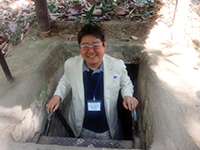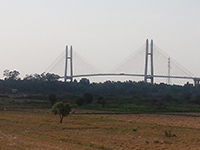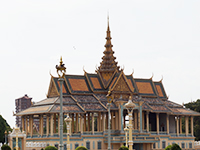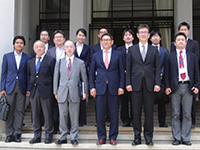Today's Notables
My Observations of Vietnam and Cambodia, Part 2
June 2016
Hisashi Furuichi
President and C.E.O.

The next part of my visit in Vietnam was the Cu Chi Tunnels, before moving to Cambodia. The Cu Chi Tunnels in South Vietnam were used by the Viet Cong during the Vietnam War. They provided a base of operations to carry out the Tet Offensive among other guerrilla warfare. There are over 250km in total of the tunnels that run 70km from Ho Chi Minh City and connect 16 villages in the south of Vietnam, close to the border of Cambodia. The tunnels were used by the Viet Cong to hide, meet with other military personnel, and plan offensives and contain meeting rooms, living quarters and other facilities. It is said that over 10,000 Viet Cong used the network of tunnels as protection as they fought the US military. It is often said in Vietnam that it was the knowledge and tenacity of the Viet Cong, who built the tunnel network, that contributed to the defeat of America in the Vietnam War. Although I entered the tunnel, the height of the tunnels was barely 1m and my shoulders hit the sides of the walls, not to mention that it was pitch dark, so I didn't go far. Despite the smaller stature of Vietnamese people, it was clear that living and working in the tunnels would have been difficult, constituting the ultimate choice in some cases.

After the Cu Chi Tunnels, we headed to Cambodia to see the Tsubasa Bridge built with ODA funds provided by Japan. Although it takes longer to go through immigration going from Vietnam to Cambodia by land, it was worth the wait to see the bridge from that view. Locals call the bridge Neak Loeung Bridge. It connects Cambodia highway 1 and spans the Mekong River. That same highway connects Ho Chi Minh City, Phnom Penh, and Bangkok, and is a major artery of travel and distribution among ASEAN countries. It is part of the Southern Mekong Economic Corridor. Before the construction of the brige, the only method of crossing was a ferry, and because of the traffic, it led to long waits and created huge bottlenecks in movement. Economic conditions in Cambodia made it difficult for the government to initiate a large-scale construction project, so the government made the request to Japan, and the bridge was built largely through aid made available by Japan. The bridge has significantly allowed for greater, easier travel, contributing to growth in the Cambodian economy. The road into Phnom Penh after crossing the bridge is unfinished in places and is still far from the highway that we would imagine.

In contrast to Ho Chi Minh City where bikes were all over the place, we saw Mercedes, Range Rovers, Lexus and other such luxury cars. I was also surprised to see many hybrid vehicles. In fact, I think the percentage of hybrids was greater than in Seoul or Bangkok. This is probably in due partly to high gasoline prices, and because it is a status symbol for people with money to drive hybrid vehicles. We stayed at the extremely luxurious Hotel Sofitel Phnom Penh Phokeethra. Nearby is the Aeon Mall, and not far beyond that is Toyoko Inn, both have signage just like they do in Japan. The Phnom Penh economy has surged, causing land prices to increase 400 times in some places, and it is the landowners who have become wealthy from this increase that shop at Aeon and drive luxury cars. Land prices in Boeung Keng Kang, which is popular among foreign residents, have increased from 1,500-1800 USD/m2 in 2011 to 2,000-2,500 USD/m2 in 2013. It is easy to tell from the cars in the parking lot of Aeon Mall that there are about 5 times more vehicles from Phnom Penh than from Ho Chi Minh City, an indicator of the economic conditions and vehicle use in Ho Chi Minh City in comparison to Phnom Penh.
Although Cambodia is enjoying economic growth in recent years, the dark reign of Pol Pot is not too far in its past. Pol Pot and the Khmer Rouge movement which he led, is directly related to the Vietnam War. In fact, when the US pulled out its forces in 1973, Pol Pot was able to quickly gain power. Pol Pot espoused the Marxist-Leninist ideology of communist China under Mao, and attempted to eradicate all the trappings of a capitalist society. He was especially fearful of the educated classes, especially doctors, teachers, engineer and other intelligensia, who were often the target of his repeated crackdowns. It is said that over 1,000,000 people were massacred during his reign. We visited the Tuol Sleng Genocide Museum which was a high school converted to security prison used during the reign of Khmer Rouge. Some things were so disturbing that I had to look away.

The day before our last day, we visited the Council for the Development of Cambodia and attended a reception by the Minister of Development. He discussed economic development of Cambodia and how Japanese corporations have invested in the country. The role that Japan, both government and industry, has been playing in Cambodia has been significant and will likely continue to be in the future. In the evening we visited the JICA-led Cambodia-Japan Cooperation Center to train young Cambodian entrepreneurs. We met and had some discussions with people who graduated from that program and were now working in private enterprises. On the final day, we visited an industrial park that is inhabited mostly by Japanese corporations and went on a factory tour of Sumitomo Densen. Sumitomo Densen has approximately 2,000 employees at the facility where it manufacturers electronic harnesses for Lexus and other Toyota vehicles. The vast majority of the people that work in the factory are young women in their early 20s. The factory gets many new recruits who often misrepresent their age and level of education. Many have not received education beyond the primary school precisely because of the lingering influence of Pol Pot. Since many of them do not have the math or languages skills (language used in a factory setting), fundamental training and education is required. Despite those challenges, Sumitomo Densen is proud that the factory has zero quality issues, a testament to the strength of its management.
Thanks to the efforts of the Kansai Association of Corporate Executives, we were able to visit some companies and organizations that would have been impossible otherwise. The trip was a tremendous learning experience. It gave me food for thought as far as how PRIMIX's own strategy might include ASEAN countries and how we can support and participate in the economic growth of that region.
HOME > What’s New > Today's Notables > Details














